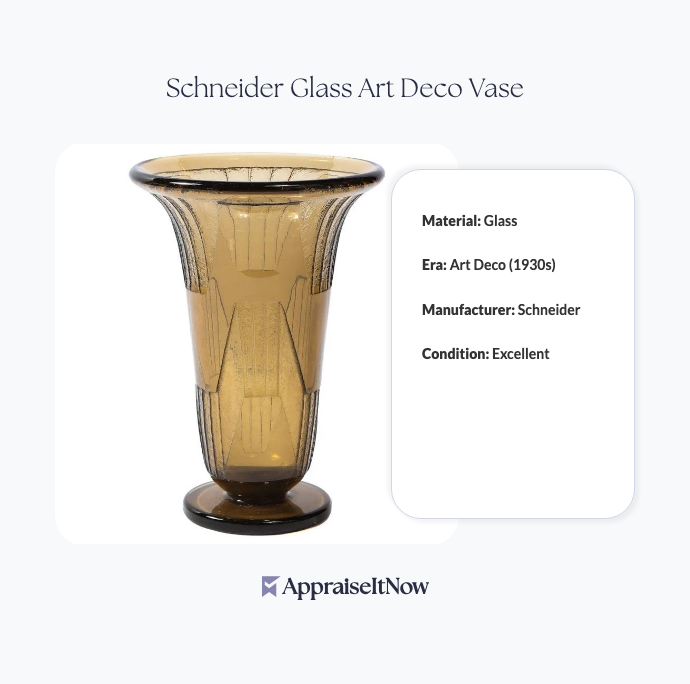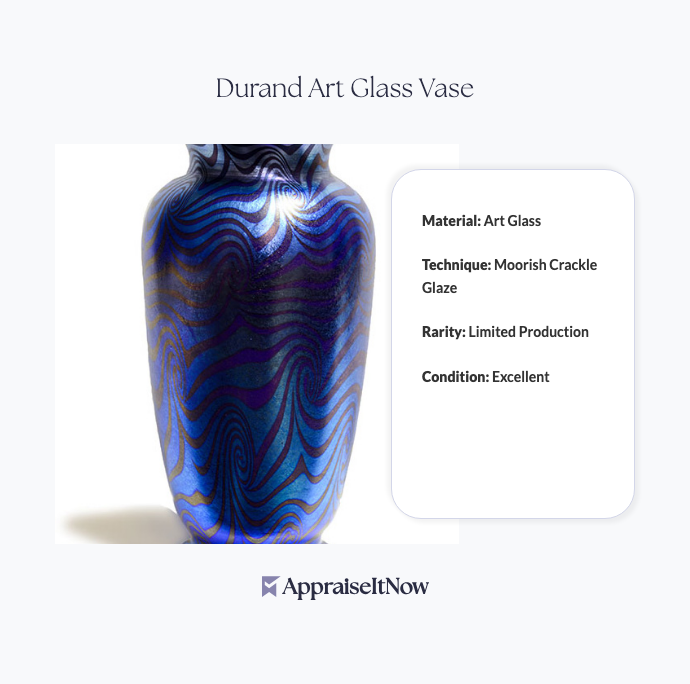<h1>How to Get Your Loetz Papillon Glass Vase Appraised</h1>
<p>If you own a Loetz Papillon Glass Vase or suspect you might, understanding its value through professional appraisal is essential. These stunning pieces of Austrian art glass from the late 19th century command significant market prices—typically <strong>$2,500 to $3,500</strong> for quality examples—making accurate valuation crucial whether you're considering a sale, seeking insurance coverage, or simply curious about what sits on your shelf.</p>
<h2>What Makes Loetz Glass So Collectible</h2>
<p>The Loetz Papillon vase represents the pinnacle of Art Nouveau craftsmanship. Created by the <strong>Loetz glassworks in Austria</strong>, these vases feature iridescent, butterfly-like patterns that seem to shimmer and shift as light plays across their surfaces. The term "Papillon"—French for butterfly—perfectly captures the delicate, organic appearance that defines these highly sought-after pieces.</p>
<p>What makes Loetz glass valuable extends beyond mere aesthetics. These vases were first introduced in <strong>1890</strong> using specialized molds and advanced techniques involving metallic oxide applications that were revolutionary for their time. The combination of technical innovation, artistic vision, and limited production numbers created pieces that museums worldwide now treasure in their collections. When exploring <a href="/blog/how-to-find-a-qualified-appraiser-for-antique-artwork">antique artwork appraisals</a>, understanding this historical context helps you appreciate why your Papillon vase deserves professional evaluation.</p>
<div class="callout tip"><p><strong>Collector's Insight</strong></p>
<p>Loetz glass from the Papillon pattern era (1890-1910) represents some of the finest examples of iridescent glass ever produced, with values continuing to appreciate as collector interest grows.</p></div>
<h2>Understanding Loetz Glass Value Factors</h2>
<p>Your Loetz Papillon vase's worth depends on several interconnected factors that professional appraisers systematically evaluate. The iridescent colors and patterns aren't random—they result from carefully controlled firing processes that created unique variations in every piece. This means no two Papillon vases are identical, making each one individually significant.</p>
<p>Condition plays a critical role in determining value. Even minor chips, cracks, or wear to the iridescent surface can substantially reduce worth. Original, undisturbed examples with intact patterns and brilliant luster command premium prices, while pieces requiring restoration may fall toward the lower end of the $2,500-$3,500 range. The question <em>"How do I know if my vase is worth money?"</em> often hinges on condition assessment—something expert appraisers perform with specialized equipment and trained eyes.</p>
<p>Size and specific pattern variations within the Papillon line also affect pricing. Larger vases with more complex, intact patterns typically achieve higher valuations than smaller examples. Understanding these nuances requires expertise in <a href="/blog/appraising-fine-glass-and-crystal-valuing-delicate-glassware-and-artistic-creations">fine glass and crystal appraisals</a>, a specialized field within the broader antiques market.</p>
<h2>Identifying Your Loetz Vase Authenticity</h2>
<p>Before seeking professional appraisal, confirming authenticity matters. The question <em>"How to identify a Loetz glass vase?"</em> requires examining several key characteristics. Authentic Loetz Papillon pieces typically feature:</p>
<ul>
<li>Iridescent surface with butterfly-patterned effects</li>
<li>Organic, curving forms characteristic of Art Nouveau design</li>
<li>Smooth, high-quality glass without visible bubbles or irregularities</li>
<li>Warm, glowing colors that shift under different lighting conditions</li>
<li>Possible maker's marks, though not all pieces were marked</li>
</ul>
<p>Many collectors wonder, <em>"Is Loetz glass valuable?"</em> The answer is unequivocally yes—particularly Papillon pattern examples. What distinguishes Loetz from other decorative glass includes its superior iridescence quality and the technical mastery required to produce consistent results using turn-of-the-century manufacturing processes. When comparing to other <a href="/types/memorabilia-and-collectibles">memorabilia and collectibles</a>, Loetz pieces hold their value exceptionally well.</p>
<div class="callout note"><p><strong>Authentication Tip</strong></p>
<p>Loetz vases often lack maker's marks; however, characteristic form, color quality, and iridescent patterns are diagnostic. Professional appraisers can confirm authenticity through visual assessment and, if necessary, scientific analysis of glass composition.</p></div>
<h2>When and Why Professional Appraisal Matters</h2>
<p>Understanding <em>"What makes Loetz glass so collectible?"</em> academically differs from knowing your specific piece's market value. Professional appraisers provide certified valuations that serve multiple purposes. Whether you're filing insurance claims, planning estate distributions, or negotiating private sales, a documented appraisal from a credentialed expert carries legal and financial weight.</p>
<p>The appraisal process for decorative glass involves more than estimating value. Certified appraisers create detailed condition reports, photograph pieces from multiple angles, document any repairs or alterations, and research comparable sales to establish fair market value. This documentation becomes invaluable if you file insurance claims or need to prove value for legal proceedings. Many collectors ask, <em>"How do I get a vase value?"</em>—the answer is through professional assessment by specialists experienced in <a href="/blog/unraveling-the-mysteries-of-antique-appraisals-a-guide-for-collectors">antique appraisals</a>.</p>
<h2>Loetz Papillon Vases in Today's Market</h2>
<p>Current market dynamics favor Loetz collectors. These Austrian art glass pieces have steadily appreciated over recent decades as awareness of Art Nouveau design spreads and serious collectors seek museum-quality examples. The $2,500-$3,500 valuation range reflects strong demand from both institutional buyers and private collectors worldwide.</p>
<p>Premium examples—particularly larger pieces with exceptional pattern clarity and provenance documentation—can exceed this range. Smaller vases or those with minor wear typically fall at the lower end. Rarity within the Papillon line also matters; certain color combinations or documented exhibition pieces command significant premiums.</p>
<p>Understanding current market conditions requires tracking comparable sales through auction houses and specialized dealers. This is precisely where professional appraisers add value; they maintain current market knowledge and access to sales data that general collectors might lack. Your appraiser should discuss how recent comparable sales inform their valuation, ensuring you understand the reasoning behind the final assessment.</p>
<div class="callout tip"><p><strong>Market Insight</strong></p>
<p>Loetz Papillon vases consistently perform well at major auction houses, with authenticated examples regularly selling within or above estimated ranges, indicating healthy collector demand and stable valuations.</p></div>
<h2>Preparing Your Vase for Appraisal</h2>
<p>When you decide to get your Loetz Papillon vase appraised, preparation ensures the appraiser can accurately assess condition and value. Clean the piece gently with soft, dry materials—never use harsh chemicals or abrasive cleaning methods that might damage the delicate iridescent surface. Document any existing damage, repairs, or alterations before the appointment.</p>
<p>Gather any available documentation: purchase receipts, previous appraisals, exhibition catalogs if your piece was displayed, or family records about the vase's origins. Provenance—the documented history of ownership—can significantly enhance value. If you know where your vase came from or who previously owned it, this information proves invaluable during appraisal. At <strong>AppraiseItNow</strong>, we understand that <a href="/blog/understanding-the-role-of-provenance-in-art-appraisals-assessing-historical-significance">understanding the role of provenance in art appraisals</a> fundamentally shapes valuation accuracy.</p>
<p>Have measurements ready (height, diameter at widest point) and note any markings, signatures, or inscriptions on the base. Take high-quality photographs from multiple angles in natural lighting, capturing both the overall form and close-up details of the iridescent patterns. This preparation facilitates efficient, thorough appraisals.</p>
<h2>Choosing the Right Appraiser</h2>
<p>Not all appraisers possess expertise in decorative glass or Art Nouveau pieces. Seek appraisers who specialize in <a href="/blog/appraising-fine-art-a-comprehensive-guide-for-art-collectors-and-investors">fine art and antiques valuations</a> and specifically demonstrate knowledge of European art glass. Look for credentials including membership in professional organizations like the American Society of Appraisers (ASA), International Society of Appraisers (ISA), or American Association of Appraisers (AAA).</p>
<p>Verify that potential appraisers follow <strong>USPAP standards</strong> (Uniform Standards of Professional Appraisal Practice), ensuring their valuations meet legal and financial institution requirements. Ask about their specific experience with Loetz glass and Austrian decorative arts. A qualified appraiser should readily discuss their methodology, explain how they determine value, and provide detailed written reports suitable for insurance or legal purposes.</p>
<p>At <strong>AppraiseItNow</strong>, our network includes certified appraisers across the country specializing in <a href="/types/artwork">artwork and collectibles</a>, ensuring you receive expert evaluation from professionals who understand what drives Loetz Papillon vase values in today's market.</p>
<h2>Documentation and Insurance Applications</h2>
<p>A professional appraisal creates a comprehensive record of your Loetz Papillon vase's condition, value, and characteristics. Insurance companies often require this documentation before issuing specialized coverage for valuable collectibles. The detailed condition report and photographs included in certified appraisals help claims adjusters understand your piece's value if damage or loss occurs.</p>
<p>For homeowner's or renter's insurance, standard policies typically cap coverage on collectibles. Scheduling your Loetz vase as a separate item—supported by professional appraisal documentation—ensures full replacement value coverage. This process mirrors <a href="/blog/understanding-artwork-appraisals">understanding artwork appraisals</a> for fine art collections, where proper documentation directly protects your investment.</p>
<p>Beyond insurance, professional appraisals serve estate planning, donation documentation for tax purposes, and probate proceedings. When family members inherit your collection, having current, documented valuations prevents disputes and simplifies distribution. For significant pieces like your Loetz Papillon vase, professional appraisal documentation becomes essential family legacy material.</p>
<div class="callout note"><p><strong>Key Takeaway</strong></p>
<p>A certified appraisal of your Loetz Papillon Glass Vase provides the documentation you need for insurance protection, legal compliance, and confidence in knowing your piece's true market value. Whether you're securing your collection or planning future transactions, professional evaluation from credentialed experts ensures accurate, defensible valuations that protect your investment and provide peace of mind.</p></div>







.avif)







